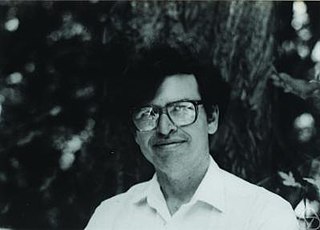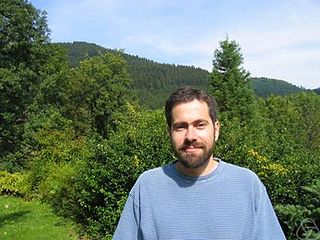
Francis Bonahon (9 September 1955, Tarbes) is a French mathematician, specializing in low-dimensional topology.

Francis Bonahon (9 September 1955, Tarbes) is a French mathematician, specializing in low-dimensional topology.
Bonahon received in 1972 his baccalauréat , and was accepted in 1974 into the École Normale Supérieure. He received in 1975 his maîtrise in mathematics from the University of Paris VII, and in 1979 his doctorate from the University of Paris XI under Laurence Siebenmann with thesis Involutions et fibrés de Seifert dans les variétés de dimension 3. [1] As a postdoc he was for the academic year 1979/80 a Procter Fellow at Princeton University. In 1980 he became an attaché de recherche and in 1983 a chargé de recherche of the CNRS. In 1985 he received his habilitation from the University of Paris XI under Siebenmann with thesis Geometric structures on 3-manifolds and applications. Bonahon became in 1986 an assistant professor, in 1988 an associate professor, and in 1989 a full professor at the University of Southern California in Los Angeles. [2]
He was a visiting professor in 1990 at the University of California, Davis, in 1996 at the Centre Émile Borel and at the IHES, in 1997 at Caltech, in 2000 at IHES, and in 2015 at the MSRI. [2]
Bonahon's research deals with three-dimensional topology, knot theory, surface diffeomorphisms, hyperbolic geometry, and Kleinian groups.
He received in 1985 a bronze medal from CNRS and from 1989 to 1994 a Presidential Young Investigator Award. From 1987 to 1989 he was a Sloan Research Fellow. In 1990 he was an Invited Speaker with talk Ensembles limites et applications at the ICM in Kyoto. He was elected a Fellow of American Mathematical Society in 2012.
His doctoral students include Frédéric Paulin.

William Paul Thurston was an American mathematician. He was a pioneer in the field of low-dimensional topology and was awarded the Fields Medal in 1982 for his contributions to the study of 3-manifolds.
In mathematics, Thurston's geometrization conjecture states that each of certain three-dimensional topological spaces has a unique geometric structure that can be associated with it. It is an analogue of the uniformization theorem for two-dimensional surfaces, which states that every simply connected Riemann surface can be given one of three geometries.

In mathematics, low-dimensional topology is the branch of topology that studies manifolds, or more generally topological spaces, of four or fewer dimensions. Representative topics are the structure theory of 3-manifolds and 4-manifolds, knot theory, and braid groups. This can be regarded as a part of geometric topology. It may also be used to refer to the study of topological spaces of dimension 1, though this is more typically considered part of continuum theory.

In mathematics, a 3-manifold is a topological space that locally looks like a three-dimensional Euclidean space. A 3-manifold can be thought of as a possible shape of the universe. Just as a sphere looks like a plane to a small and close enough observer, all 3-manifolds look like our universe does to a small enough observer. This is made more precise in the definition below.
In mathematics, more precisely in topology and differential geometry, a hyperbolic 3-manifold is a manifold of dimension 3 equipped with a hyperbolic metric, that is a Riemannian metric which has all its sectional curvatures equal to −1. It is generally required that this metric be also complete: in this case the manifold can be realised as a quotient of the 3-dimensional hyperbolic space by a discrete group of isometries.
In mathematics, the Teichmüller space of a (real) topological surface is a space that parametrizes complex structures on up to the action of homeomorphisms that are isotopic to the identity homeomorphism. Teichmüller spaces are named after Oswald Teichmüller.
In mathematics, the tameness theorem states that every complete hyperbolic 3-manifold with finitely generated fundamental group is topologically tame, in other words homeomorphic to the interior of a compact 3-manifold.

Dennis Parnell Sullivan is an American mathematician known for his work in algebraic topology, geometric topology, and dynamical systems. He holds the Albert Einstein Chair at the Graduate Center of the City University of New York and is a distinguished professor at Stony Brook University.
In geometry, Thurston's geometrization theorem or hyperbolization theorem implies that closed atoroidal Haken manifolds are hyperbolic, and in particular satisfy the Thurston conjecture.
Brian Hayward Bowditch is a British mathematician known for his contributions to geometry and topology, particularly in the areas of geometric group theory and low-dimensional topology. He is also known for solving the angel problem. Bowditch holds a chaired Professor appointment in Mathematics at the University of Warwick.
In hyperbolic geometry, the ending lamination theorem, originally conjectured by William Thurston, states that hyperbolic 3-manifolds with finitely generated fundamental groups are determined by their topology together with certain "end invariants", which are geodesic laminations on some surfaces in the boundary of the manifold.
In hyperbolic geometry, an earthquake map is a method of changing one hyperbolic manifold into another, introduced by William Thurston.
In the mathematical theory of Kleinian groups, the density conjecture of Lipman Bers, Dennis Sullivan, and William Thurston, later proved independently by Namazi & Souto (2012) and Ohshika (2011), states that every finitely generated Kleinian group is an algebraic limit of geometrically finite Kleinian groups.
In geometric group theory, the Rips machine is a method of studying the action of groups on R-trees. It was introduced in unpublished work of Eliyahu Rips in about 1991.

Yair Nathan Minsky is an Israeli-American mathematician whose research concerns three-dimensional topology, differential geometry, group theory and holomorphic dynamics. He is a professor at Yale University. He is known for having proved Thurston's ending lamination conjecture and as a student of curve complex geometry.
In mathematics, the curve complex is a simplicial complex C(S) associated to a finite-type surface S, which encodes the combinatorics of simple closed curves on S. The curve complex turned out to be a fundamental tool in the study of the geometry of the Teichmüller space, of mapping class groups and of Kleinian groups. It was introduced by W.J.Harvey in 1978.

Jeffrey Farlowe Brock is an American mathematician, working in low-dimensional geometry and topology. He is known for his contributions to the understanding of hyperbolic 3-manifolds and the geometry of Teichmüller spaces.
Albert Marden is an American mathematician, specializing in complex analysis and hyperbolic geometry.
Godfrey Peter Scott, known as Peter Scott, was a British-American mathematician, known for the Scott core theorem.

Nicolas Bergeron was a French mathematician who worked in Pierre and Marie Curie University in Paris.